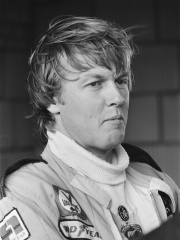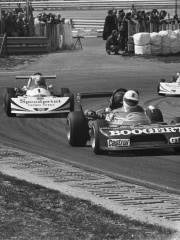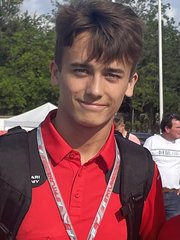







The Most Famous
RACING DRIVERS from Sweden
This page contains a list of the greatest Swedish Racing Drivers. The pantheon dataset contains 1,080 Racing Drivers, 25 of which were born in Sweden. This makes Sweden the birth place of the 13th most number of Racing Drivers behind Argentina, and Australia.
Top 10
The following people are considered by Pantheon to be the top 10 most legendary Swedish Racing Drivers of all time. This list of famous Swedish Racing Drivers is sorted by HPI (Historical Popularity Index), a metric that aggregates information on a biography's online popularity. Visit the rankings page to view the entire list of Swedish Racing Drivers.

1. Keke Rosberg (b. 1948)
With an HPI of 72.84, Keke Rosberg is the most famous Swedish Racing Driver. His biography has been translated into 45 different languages on wikipedia.
Keijo Erik "Keke" Rosberg (Finnish pronunciation: [ˈkeke ˈruːsbæri] ; born 6 December 1948) is a Finnish former racing driver and motorsport executive, who competed in Formula One from 1978 to 1986. Rosberg won the Formula One World Drivers' Championship in 1982 with Williams, and won five Grands Prix across nine seasons. Born in Sweden and raised in Finland, Rosberg started his racing career in karting before graduating to Formula Vee in 1972. Upon winning Finnish Championship the following year, Rosberg progressed to Formula Super Vee, where he won the German Championship in 1975. He then moved to European Formula Two, competing from 1976 to 1979. Aged 29, Rosberg made his Formula One debut for Theodore at the 1978 South African Grand Prix. He spent the remainder of the 1978 season with Theodore and ATS, winning the non-championship BRDC International Trophy with the former in his second Formula One appearance. Rosberg returned in 1979 with Wolf, replacing the retired James Hunt from the French Grand Prix onwards. After another non-classified championship finish, Rosberg signed for Fittipaldi in 1980 to partner Emerson Fittipaldi, scoring his maiden points and podium finish on debut. After two years with Fittipaldi, Rosberg signed for Williams in 1982. He secured his maiden victory during his first season with the team—at the Swiss Grand Prix—and his five further podiums saw him clinch the title at the final race of the season, becoming the first World Drivers' Champion from Finland. Rosberg was unable to defend his title in 1983 as Williams struggled to adapt to the turbo era, despite winning the Monaco Grand Prix and the final non-championship Race of Champions. He took further wins for Williams at the Dallas Grand Prix in 1984, and the Detroit and Australian Grands Prix in 1985, finishing third in the latter championship. Moving to reigning champions McLaren in 1986 to partner Alain Prost, Rosberg was unable to win all year as his teammate took the title, retiring at the end of the season with five race wins, five pole positions, three fastest laps and 17 podiums. Outside of Formula One, Rosberg achieved multiple race wins in the World Sportscar Championship with Peugeot from 1990 to 1991, and was a race-winner in the Deutsche Tourenwagen Meisterschaft, competing from 1992 to 1995. Since retiring from motor racing, Rosberg has moved into driver management, formerly managing two-time 24 Hours of Le Mans winner JJ Lehto and two-time World Drivers' Champion Mika Häkkinen. He also coached and managed his son Nico from karting at an early age to winning the World Drivers' Championship in 2016. Since 1994, he has owned and managed Team Rosberg, leading them to championships in German Formula Three, Formula BMW, the Deutsche Tourenwagen Masters, and Extreme E.

2. Ronnie Peterson (1944 - 1978)
With an HPI of 71.04, Ronnie Peterson is the 2nd most famous Swedish Racing Driver. His biography has been translated into 35 different languages.
Bengt Ronnie Peterson (Swedish: [ˈrɔ̌nːɪ ˈpêtːɛˌʂɔn]; 14 February 1944 – 11 September 1978) was a Swedish racing driver, who competed in Formula One from 1970 to 1978. Nicknamed "Superswede", Peterson twice finished runner-up in the Formula One World Drivers' Championship in 1971 and 1978, and won ten Grands Prix across nine seasons. Peterson began his motor racing career in kart racing, traditionally the discipline where the majority of race drivers begin their careers in open-wheel racing. After winning a number of karting titles, including two Swedish titles in 1963 and 1964, he moved on to Formula Three, where he won the Monaco Grand Prix Formula Three support race for the 1969 Grand Prix. Later that year he won the FIA European Formula 3 Championship and moved up into Formula One, racing for the March factory team. In his three-year spell with the team, he took six podiums, most of which were scored during the 1971 Formula One season in which he also finished as runner-up in the Drivers' Championship. After seeing out his three-year contract at March, Peterson joined Colin Chapman's Team Lotus in the 1973 season, partnering defending champion Emerson Fittipaldi. During his first two seasons with Lotus, Peterson took seven victories, scoring a career-best 52 points in 1973. After a poor 1975 season, Peterson moved back to March and scored his final victory for the team at the 1976 Italian Grand Prix. After spending the 1977 season with Tyrrell, he moved back to Lotus for the 1978 season as number two driver to Mario Andretti. Peterson scored two wins, at the South African and Austrian Grand Prix races, and finished second in the Drivers' Championship standings despite his fatal first-lap accident at Monza during the Italian Grand Prix.

3. Jo Bonnier (1930 - 1972)
With an HPI of 65.68, Jo Bonnier is the 3rd most famous Swedish Racing Driver. His biography has been translated into 24 different languages.
Joakim "Jo" Bonnier (31 January 1930 – 11 June 1972) was a Swedish racing driver and team owner, who competed in Formula One from 1956 to 1971. Bonnier won the 1959 Dutch Grand Prix with BRM. Born and raised in Stockholm, Bonnier was the son of geneticist Gert Bonnier and born into the wealthy Bonnier family, the controlling family of the eponymous Bonnier Group. Bonnier competed in Formula One for Maserati, Scuderia Centro Sud, BRM, Porsche, Rob Walker Racing and Ecurie Bonnier, winning the Dutch Grand Prix with BRM to become the first Swedish Formula One Grand Prix winner and finishing eighth in the World Drivers' Championship that year. Outside of Formula One, Bonnier entered 13 editions of the 24 Hours of Le Mans from 1957 to 1972, finishing runner-up in 1964 alongside Graham Hill, driving the Ferrari 330P. During the latter, Bonnier died when his Lola T280 collided with traffic and left him critically injured. Until his death, Bonnier had been the chairman of the Grand Prix Drivers' Association.

4. Björn Waldegård (1943 - 2014)
With an HPI of 63.44, Björn Waldegård is the 4th most famous Swedish Racing Driver. His biography has been translated into 24 different languages.
Björn Waldegård (12 November 1943 – 29 August 2014) was a Swedish rally driver, and the winner of the World Rally Championship for drivers in 1979. His Swedish nickname was "Walle".

5. Stig Blomqvist (b. 1946)
With an HPI of 63.00, Stig Blomqvist is the 5th most famous Swedish Racing Driver. His biography has been translated into 26 different languages.
Stig Lennart Blomqvist (born 29 July 1946) is a retired Swedish rally driver. He made his international breakthrough in 1981. Driving an Audi Quattro for the Audi factory team, Blomqvist won the World Rally Championship drivers' title in 1984 and finished runner-up in 1985. He won his home event, the Swedish Rally, seven times. Outside the WRC, he won the British Rally Championship in 1983 and the Swedish Rally Championship several times. At the Race of Champions, Blomqvist took the title "Champion of Champions" in 1989 and 1990.

6. Stefan Johansson (b. 1956)
With an HPI of 61.99, Stefan Johansson is the 6th most famous Swedish Racing Driver. His biography has been translated into 26 different languages.
Stefan Nils Edwin Johansson (born 8 September 1956) is a Swedish former racing driver and motorsport executive, who competed in Formula One between 1980 and 1991. In endurance racing, Johansson won the 24 Hours of Le Mans in 1997 with Joest. Born and raised in Växjö, Johansson began his career in kart racing, winning the Swedish Championship in 1973. After achieving multiple national titles in Formula Ford, Johansson progressed to British Formula Three, winning the championship in 1980. Johansson also made his Formula One debut that year—at the Argentine Grand Prix with Shadow—but did not qualify for either round he contested. Following multiple race wins in European Formula Two and podiums in the World Sportscar Championship, Johansson returned to Formula One in 1983 with Spirit. After sporadic appearances for Tyrrell and Toleman in 1984, Johansson signed for Ferrari the following season, achieving his maiden podium finish in Canada. Retaining his seat for 1986, Johansson scored several podiums as he finished a career-best fifth in the World Drivers' Championship. Replaced by Gerhard Berger at Ferrari in 1987, Johansson moved to McLaren to partner Alain Prost; he scored five podiums on his way to sixth in the standings, but left for Ligier at the end of the season. After a non-classified championship finish in 1988, Johansson moved to Onyx, scoring the team's only podium finish at the 1989 Portuguese Grand Prix. He was dropped by Onyx after the 1990 Brazilian Grand Prix, making further appearances for AGS and Footwork in 1991 before leaving Formula One, having achieved 12 podiums. In addition to his ten seasons in Formula One, Johansson entered 15 editions of the 24 Hours of Le Mans between 1983 and 2012, taking three class wins amongst an overall win in 1997, driving the Porsche WSC-95 alongside Michele Alboreto and Tom Kristensen. He also competed in the IndyCar World Series from 1992 to 1996, both seasons of Grand Prix Masters, and the inaugural season of the FIA World Endurance Championship.

7. Reine Wisell (1941 - 2022)
With an HPI of 61.94, Reine Wisell is the 7th most famous Swedish Racing Driver. His biography has been translated into 27 different languages.
Reine Tore Leif Wisell (30 September 1941 – 20 March 2022) was a Swedish racing driver. He participated in 23 Formula One World Championship Grands Prix, debuting on 4 October 1970. He achieved one podium, and scored a total of 13 championship points.

8. Gunnar Nilsson (1948 - 1978)
With an HPI of 61.88, Gunnar Nilsson is the 8th most famous Swedish Racing Driver. His biography has been translated into 25 different languages.
Gunnar Axel Arvid Nilsson (20 November 1948 – 20 October 1978) was a Swedish racing driver, who competed in Formula One from 1976 to 1977. Nilsson won the 1977 Belgian Grand Prix with Lotus. Born and raised in Helsingborg, Nilsson initially studied engineering at Stockholm University and served as a submarine radio officer in the Swedish Navy. Nilsson began his racing career in the late 1960s, progressing into Formula Super Vee in 1973 with Ecurie Bonnier. His junior formulae career culminated in his victory at the 1975 British Formula 3 Championship, in only his second season of Formula Three racing. Nilsson signed for Lotus in 1976, making his Formula One debut at the South African Grand Prix. Qualifying for every race in his rookie season, Nilsson scored podium finishes in Spain and Austria. Retaining his seat for 1977, Nilsson scored his maiden win at the Belgian Grand Prix, with a further podium at the British Grand Prix. Having signed to Arrows for 1978, Nilsson was diagnosed with testicular cancer in December 1977, experiencing a rapid decline in health prior to his death 10 months later. Outside of Formula One, Nilsson was a race-winner in both the World Sportscar and European Touring Car Championships with BMW. The Gunnar Nilsson Memorial Trophy was held in 1979, won by Alan Jones.

9. Ove Andersson (1938 - 2008)
With an HPI of 61.72, Ove Andersson is the 9th most famous Swedish Racing Driver. His biography has been translated into 24 different languages.
Ove Andersson (3 January 1938 – 11 June 2008), nicknamed Påven ("the Pope"), was a Swedish rally driver and the first head of Toyota's F1 programme.

10. Conny Andersson (b. 1939)
With an HPI of 61.02, Conny Andersson is the 10th most famous Swedish Racing Driver. His biography has been translated into 24 different languages.
Conny Andersson (born 28 December 1939) is a Swedish former racing driver who participated in Formula One during 1976 and 1977 for the Surtees and BRM teams. Earlier, he was a motocross rider who competed in Formula Three racing as a privateer for almost ten years. He won the 1974 Swedish Formula Three Championship and the 1975 European Formula Three Championship at Monaco. The next season, he won four more races.
People
Pantheon has 25 people classified as Swedish racing drivers born between 1930 and 2004. Of these 25, 16 (64.00%) of them are still alive today. The most famous living Swedish racing drivers include Keke Rosberg, Stig Blomqvist, and Stefan Johansson. The most famous deceased Swedish racing drivers include Ronnie Peterson, Jo Bonnier, and Björn Waldegård. As of April 2024, 3 new Swedish racing drivers have been added to Pantheon including Tina Thörner, Dino Beganovic, and Johan Kristoffersson.
Living Swedish Racing Drivers
Go to all RankingsKeke Rosberg
1948 - Present
HPI: 72.84
Stig Blomqvist
1946 - Present
HPI: 63.00
Stefan Johansson
1956 - Present
HPI: 61.99
Conny Andersson
1939 - Present
HPI: 61.02
Torsten Palm
1947 - Present
HPI: 54.23
Kenneth Eriksson
1956 - Present
HPI: 52.76
Kenny Bräck
1966 - Present
HPI: 51.06
Mattias Ekström
1978 - Present
HPI: 49.46
Marcus Ericsson
1990 - Present
HPI: 48.32
Tina Thörner
1966 - Present
HPI: 46.92
Björn Wirdheim
1980 - Present
HPI: 44.71
Daniel Carlsson
1976 - Present
HPI: 39.49
Deceased Swedish Racing Drivers
Go to all RankingsRonnie Peterson
1944 - 1978
HPI: 71.04
Jo Bonnier
1930 - 1972
HPI: 65.68
Björn Waldegård
1943 - 2014
HPI: 63.44
Reine Wisell
1941 - 2022
HPI: 61.94
Gunnar Nilsson
1948 - 1978
HPI: 61.88
Ove Andersson
1938 - 2008
HPI: 61.72
Slim Borgudd
1946 - 2023
HPI: 58.85
Kent Andersson
1942 - 2006
HPI: 57.46
Bertil Roos
1943 - 2016
HPI: 52.87
Newly Added Swedish Racing Drivers (2025)
Go to all RankingsTina Thörner
1966 - Present
HPI: 46.92
Dino Beganovic
2004 - Present
HPI: 39.37
Johan Kristoffersson
1988 - Present
HPI: 34.84
Overlapping Lives
Which Racing Drivers were alive at the same time? This visualization shows the lifespans of the 8 most globally memorable Racing Drivers since 1700.














